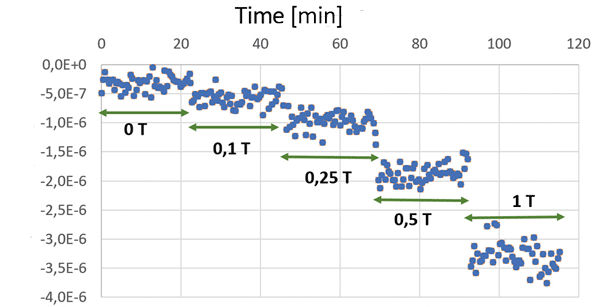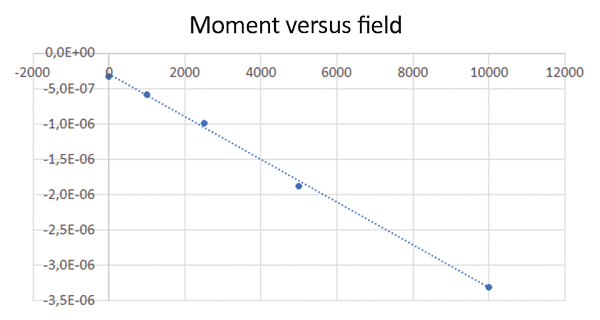Sensitivity and noise at VSM measurements – take a look behind the curtain
With the example of a VSM measurement, noise parameters from a practical viewpoint will be discussed.
The measurements were performed in our Darmstadt application laboratory using a DynaCool with VSM option.
The terms noise and sensitivity are often used synonymously, which in my opinion lacks clarity and leaves room for interpretation also in undesired directions. Noise and noise variables can be clearly defined and can then be reproduced in the laboratory, e.g. during an installation. Sensitivity, on the other hand, is not directly related to the system noise, but is more difficult to quantify and depends on details of the measurement task.
Our sample is a drop of GE Varnish adhesive on a quartz sample holder, with other words a small amount of diamagnetic material. For this sample, the magnetic moment is measured with the VSM option at different fields up to 1 Tesla. Typical measurement parameters are chosen: 40 Hz frequency, 2 mm amplitude, 5 seconds averaging for each data point, about 50 data points per field (so that we can draw on a certain amount of statistics). The temperature is kept constant at 300 K and the fields are always set in the “persistent mode”. The whole procedure takes about two hours, mainly due to the number of data points per field. Figure 1 shows the measuring points.
The system software “MultiVu” outputs a corresponding error for each data point (named “M.St.Err.” in the *.dat file). This results from a statistical use of the raw data. As is usual with VSM, the raw data are not stored. The system provides the averaged value per measurement point. The error of the individual data points is typically somewhat below 1.5E-7 emu. The data points of the zero-field measurement show the following characteristics: mean value: -3.3E-7 emu, noise band (distance between minimum and maximum value): 5.0E-7 emu, standard deviation: 1.1E-7 emu. The averaged moments for the respective fields can now be plotted against the field in order to obtain the magnetic permeability. The preselected number of 50 data points was a little too much, as a similar result would have been achieved with fewer points (and thus less measuring time).
The five mean values result in the expected straight line. I hope that this example calculation will show that the noise in VSM measurements can be quantified well and can therefore be verified again at a later point in time. What about “sensitivity”? I think the measurement shown can be classified as having a sensitivity in the lower E-7 emu range. But whether it is 1E-7 emu or 5E-7 emu (noise band) depends on further boundary conditions of the measurement.
Additional information:
The standard deviation (RMS – root mean square) was calculated on the basis of a population:
In this equation, xi represents the deviation of the i-th data point from the mean value for a number of n data points. If we refer to one sample, the denominator would be “n -1”.
For the factor between the standard deviation (RMS noise) and the noise band (peak-to-peak) a factor of 6 is a typical choice. In the case of a Gaussian distribution, this contains 99.7% of all data points (±3x standard deviation). The calculations can easily be done with Excel or similar programs..






